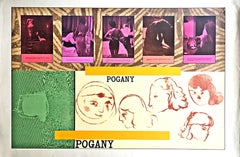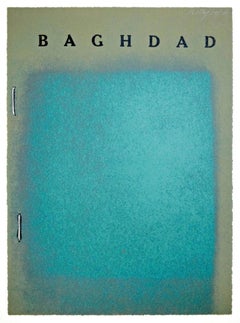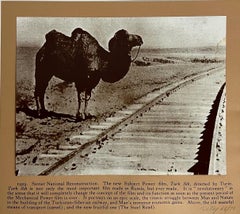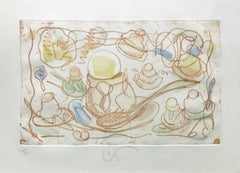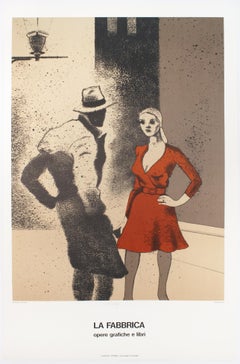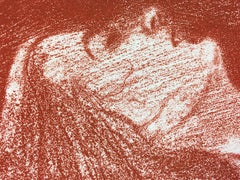Ronald Brooks Kitaj Figurative Prints
American, 1932-2007
Born in Cleveland, Ohio in 1932, R.B. (Ronald Brooks) Kitaj is considered a key figure in European and American contemporary painting. While his work has been considered controversial, he is regarded as a master draftsman with a commitment to figurative art. His highly personal paintings and drawings reflect his deep interest in history; cultural, social and political ideologies; and issues of identity.
Among his various honors are election to the American Academy of Arts and Letters in 1982, and election to the Royal Academy in 1985 (the first American since John Singer Sargent to receive this honor.)
Numerous retrospective exhibitions of his work include shows at the Hirshhorn Museum in Washington, D.C.; The Jewish Museum, Berlin; The Jewish Museum, London; and the Hamburger Kunsthalle in Germany.
Raised in Cleveland, Ohio, and Troy, New York, Kitaj joined the Merchant Marines in 1949.
In 1950, between sailings, he attended classes at the Cooper Union for the Advancement of Science and Art in New York. He went on to study drawing at the Academy of Fine Art in Vienna, Austria.
Kitaj moved to Oxford, England in 1957, and enrolled at The Ruskin School of Drawing and Fine Art, University of Oxford.
In 1959, Kitaj was accepted into Royal College of Art, London, where he befriended classmate David Hockney. Upon graduation from the RCA, Kitaj signed with Marlborough Fine Art, London, where he had his first solo exhibition in 1963. His art career began in earnest, and he found critical acclaim alongside commercial success.
A second solo show followed at Marlborough Gallery, New York, in 1965, and he sold “The Ohio Gang” to The Museum of Modern Art.
In 1969, Kitaj taught for a year at the University of California, Los Angeles.
In 1976, he coined the term “School of London” in an essay he wrote as curator of the polemical exhibition, “The Human Clay,” at the Hayward Gallery, London. The term, though loose, continues to define a group of stylistically diverse artists, including Kitaj, who were working in London at that time focusing on figural representation.
In 1981, he spent a year in Paris, France, where he focused on drawing and use of pastel.
In 1994, the Tate Gallery, London, organized a major retrospective of Kitaj’s work. Hostile and personal attacks from some critics led to what Kitaj referred to as the “Tate War.” The exhibition subsequently traveled to the Los Angeles County Museum of Art and the Metropolitan Museum of Art, New York.
Kitaj moved to Los Angeles, California, and continued to exhibit with Marlborough Fine Art and the Marlborough Gallery, New York.
In 2001 the National Gallery London organized a solo exhibition of paintings: “R.B. Kitaj In the Aura of Cezanne and Other Masters.” Kitaj focused on his “late style” in his Yellow Studio in Westwood and died in 2007.
His gift of his archive to the UCLA Library Special Collections was celebrated with exhibitions at the Skirball Cultural Center and UCLA’s Young Research Library.(Biography provided by Rosenbaum Contemporary)
to
1
15
2
2
13
4
1
4
5
6
1
Overall Height
to
Overall Width
to
5
3
1
12
9
7
4
4
2
2
2
2
2
2
2
1
1
1
1
1
17
4
7
2
27
562
391
350
305
11
5
1
1
Artist: Ronald Brooks Kitaj
Swimmer - Screenprint (Olympic Games Munich 1972)
By Ronald Brooks Kitaj
Located in Paris, FR
Ronard Brooks KITAJ
Swimmer
Screen print
Signature printed in the plate
On heavy paper 101 x 64 cm (c. 40 x 26 inch)
Made for the Olympic Games in Munich, 1972
Excellent condition
Category
1970s American Modern Ronald Brooks Kitaj Figurative Prints
Materials
Screen
R.B. Kitaj Orgasm: drawing of woman in ecstasy with pale pink and clay red
By Ronald Brooks Kitaj
Located in New York, NY
Printed in a rich terra cotta red on pale pink paper, Orgasm depicts a woman’s head in profile with a dark background. Kitaj was fascinated with the female form, often producing edgy...
Category
Late 20th Century Realist Ronald Brooks Kitaj Figurative Prints
Materials
Lithograph
POGANY rare 17 color 1960s British Pop silkscreen signed numbered edition of 70
By Ronald Brooks Kitaj
Located in New York, NY
R.B. Kitaj
POGANY, 1966
17 colour Screenprint and Photo-screenprint
24 × 36 inches
Pencil signed and numbered from the Limited Edition of 70
Hand-signed by artist, Signed & numbered ...
Category
1960s Pop Art Ronald Brooks Kitaj Figurative Prints
Materials
Screen, Pencil
BAGHDAD
By Ronald Brooks Kitaj
Located in New York, NY
Ronald Brooks (R.B.) Kitaj
BAGHDAD, 1972
Six Color Screenprint and Photoscreenprint
20 × 14 1/2 inches
Pencil signed and numbered 1/125
Printed at Kelpra Studio, London
Published by ...
Category
1970s Pop Art Ronald Brooks Kitaj Figurative Prints
Materials
Screen
R.B. Kitaj Screenprint Collage Hand Signed British Pop Art Film Still Camel
By Ronald Brooks Kitaj
Located in Surfside, FL
The Most Important Film Ever Made, 1972
Color screen print and collage, from the edition of 70.
15 x 17 in
38.1 x 43.2 cm
Published by the artist with Marlborough Graphics at the Kelpra studio in 1972. This work is also in the collections of TATE London and the Victoria & Albert Museum. the price reflects the fact that there is no backing page.
Stylistically, these are hybrid works, influenced by Pop art and the modernist tradition of the Readymade, a work of art created when a mundane found object is named as an artwork and set in an art context. This avant-garde concept was originally invented by the Dada master Marcel Duchamp early in the twentieth century. In the 1960s it received renewed attention at a time when artistic norms were again being questioned. Reacting to Andy Warhol’s Pop imagery, Kitaj poignantly called his repurposed lithograph and silkscreen book covers “his soup can, his Liz Taylor.” The blatant use of images taken directly from commercial sources situates In Our Time as a precursor of appropriation art. In turning book covers into works of art, Kitaj is offering fragments of a history of knowledge, in which the content of each volume is at once mysterious and absent. Coming from this passionate bibliophile, the series is nothing less than an intellectual self-portrait.
R.B. Kitaj, in full Ronald Brooks Kitaj . Ron Kitaj...
Category
1960s Pop Art Ronald Brooks Kitaj Figurative Prints
Materials
Screen
the Spirit of the Ghetto Screenprint British Pop Art RB Kitaj Judaica Silkscreen
By Ronald Brooks Kitaj
Located in Surfside, FL
R.B. Kitaj (1932-2007)
Spirit of the Ghetto
Original seven color silkscreen on paper
Signature: Hand signed by the artist in pencil lower right
Edition: From the small, limited edition of 25, pencil numbered lower right 2/25
Sight Size: 23-1/2" x 17-1/2" Frame Size: 27" x 21.5"
In Tate collection, London.
Ronald Brooks Kitaj RA 1932 – 2007 was an American artist with Jewish roots who spent much of his life in England. He became a merchant seaman with a Norwegian freighter when he was 17. He studied at the Akademie der bildenden Künste in Vienna and the Cooper Union in New York City. After serving in the United States Army for two years, in France and Germany, he moved to England to study at the Ruskin School of Drawing and Fine Art in Oxford (1958–59) under the G.I. Bill, where he developed a love of Cézanne, and then at the Royal College of Art in London (1959–61), alongside David Hockney, Derek Boshier, Peter Phillips, Allen Jones and Patrick Caulfield. Richard Wollheim, the philosopher and David Hockney remained lifelong friends.
"Through an earlier pre-occupation with turn-of-the-century intellectual life in Vienna (where he had started his art studies in the early 1950s), as well as an admiration for the Warburg Institute approach to the history of art-in-its-intellectual-context (since after Vienna he had moved to Oxford to study with the art historian Edgar Wind, before going on to the Royal College of Art) Kitaj has come to identify most strongly with the central European Jewish writer Franz Kafka, and with his sense of estrangement and of hidden mysteries. Illustrations to Kafka's aphorisms, imaginary portraits of his fiancée Felice and Count West-West who owned The Castle, appear in the Little Pictures, as do rapidly sketched portraits of Karl Kraus, Paul Celan, Leon Trotsky and Ludwig Wittgenstein, representations of Judeo-Christian mysteries of the hidden face of God.
Kitaj settled in England, and through the 1960s taught at the Ealing Art College, the Camberwell School of Art and the Slade School of Art. He also taught at the University of California, Berkeley in 1968. He staged his first solo exhibition at Marlborough New London Gallery in London in 1963, entitled "Pictures with commentary, Pictures without commentary", in which text included in the pictures and the accompanying catalogue referred to a range of literature and history, citing Aby Warburg's analysis of symbolic forms as a major influence.
He curated an exhibition for the Arts Council at the Hayward Gallery in 1976, entitled "The Human Clay" (an allusion to a line by W. H. Auden), including works by 48 London artists, such as William Roberts, Richard Carline, Colin Self and Maggi Hambling, championing the cause of figurative art at a time when abstract was dominant. In an essay in the controversial catalogue, he invented the phrase the School of London to describe painters such as Frank Auerbach, Leon Kossoff, Francis Bacon, Lucian Freud, Euan Uglow, Michael...
Category
1970s Pop Art Ronald Brooks Kitaj Figurative Prints
Materials
Screen
Portrait of Chris Prater
By Ronald Brooks Kitaj
Located in Llanbrynmair, GB
’Chris Prater’
By Ronald Brooks Kitaj
Medium - Screen Print
Signed - Yes
Edition - 150
Size - 630mm x 920mm
Date - 1980
Condition - 10
Colour of print may not be accurate when viewe...
Category
1980s Other Art Style Ronald Brooks Kitaj Figurative Prints
Materials
Screen
"Performing Arts Center" lithograph by R. B. Kitaj from "New York, New York"
By Ronald Brooks Kitaj
Located in Boca Raton, FL
"Performing Arts Center" lithograph of dancers and musicians by R. B. (Ronald Brooks) Kitaj from the "New York, New York" portfolio published by the New York Graphic Society. Signed ...
Category
1980s Contemporary Ronald Brooks Kitaj Figurative Prints
Materials
Lithograph
Cap'n A.B Dick (A) gray fisherman portrait sou'wester hat R.B. Kitaj lithograph
By Ronald Brooks Kitaj
Located in New York, NY
Kitaj’s drawing is of a fisherman in profile, wearing a sou’wester: a collapsible rain hat. The image is a wry portrait, ostensibly of Albert Blake Dick, ...
Category
1970s Realist Ronald Brooks Kitaj Figurative Prints
Materials
Lithograph
Nude Sculpture R.B. Kitaj drawing of nude woman on handmade orange paper print
By Ronald Brooks Kitaj
Located in New York, NY
Here Kitaj depicts a sculpture of a nude woman, shaded delicately in black, printed on wonderfully textured handmade muted orange paper. The woman’s hand reaches to the inside of her thigh, and she stands with her right leg turned out to the side, gazing downward with eyes closed. This print is a sensitively-drawn example of Kitaj's interest in playful, sensual compositions that were often inspired by art historical references, such as Edward Degas...
Category
Late 20th Century Modern Ronald Brooks Kitaj Figurative Prints
Materials
Lithograph
Vintage SIGNED Kitaj Poster, La Fabbrica, Milan (A Life 1975) woman in red dress
By Ronald Brooks Kitaj
Located in New York, NY
Printed in 1975, this poster features the encounter between an alluring woman dressed in red, and a man with his back to the viewer. The light of a streetlamp is beautifully imitated...
Category
Late 20th Century Modern Ronald Brooks Kitaj Figurative Prints
Materials
Lithograph
FIRST SERIES - SOME POETS.
By Ronald Brooks Kitaj
Located in Portland, ME
Kitaj, R. B. FIRST SERIES - SOME POETS. Marlborough AG, Schellenburg, FL, 1970. Number 69 of the edition of 70 (there were about 15 additional proofs for the Artist, the Printer, and...
Category
1970s Ronald Brooks Kitaj Figurative Prints
Materials
Screen
Dominie in Catalonia, Kitaj drawing black white portrait of young girl with hat
By Ronald Brooks Kitaj
Located in New York, NY
This hand-drawn black and white portrait of Dominie, Kitaj’s adopted daughter, is one of the few etchings produced by the artist. The shape of Dominie’s wide sunhat and its patterned...
Category
Late 20th Century Ronald Brooks Kitaj Figurative Prints
Materials
Etching
Ed Dorn
By Ronald Brooks Kitaj
Located in New York, NY
color silkscreen, edition of 70
Category
1960s Pop Art Ronald Brooks Kitaj Figurative Prints
Materials
Screen
From the Lives of the Saints
By Ronald Brooks Kitaj
Located in New York, NY
R.B. Kitaj
From the Lives of Saints, 1975
color screenprint
40 1/2 x 28 inches
Edition of 70
Category
1970s Ronald Brooks Kitaj Figurative Prints
Materials
Screen
Acheson Go Home
By Ronald Brooks Kitaj
Located in New York, NY
This piece is a color silkscreen, constructed from various pieces of propaganda that Kitaj encountered while studying in Vienna in 1951. It also includes photographs of Kitaj himself...
Category
1960s Ronald Brooks Kitaj Figurative Prints
Materials
Screen
Ezra Pound II
By Ronald Brooks Kitaj
Located in New York, NY
Abstract male figure on silkscreen
R.B. Kitaj was born in Cleveland, Ohio in 1932, and as a child attended art classes at the Cleveland Museum of Art. Following his studies at Coo...
Category
1970s Ronald Brooks Kitaj Figurative Prints
Materials
Screen
Related Items
SEATED SEAMSTRESS Signed Lithograph Young Woman, Dress Form, Rust, Lime Yellow
By Raphael Soyer
Located in Union City, NJ
SEATED SEAMSTRESS is an original hand drawn (not digitally or photo reproduced) limited edition lithograph by the artist Raphael Soyer - Russian/American Social Realism...
Category
1970s Realist Ronald Brooks Kitaj Figurative Prints
Materials
Lithograph
ICE CREAM DESSERTS
By Claes Oldenburg
Located in Aventura, FL
Hand initialed and numbered by the artist. Etching and aquatint in colors, on handmade paper. Image size: 13.5 X 21.25 in. Sheet size: 22.5 x 31.25 in. Framed. Edition of 50. Artwor...
Category
1970s Pop Art Ronald Brooks Kitaj Figurative Prints
Materials
Handmade Paper, Etching, Aquatint
Kansei (2010). Limited Edition (print) by Takashi Murakami signed, numbered
By Takashi Murakami
Located in Hong Kong, HK
Kansei: Like The River's Flow
2010 by Takashi Murakami
Offset print, cold stamp and high gloss varnishing with silver ink
signed, numbered and stamped by the Artist
27 7/8 in diamete...
Category
Early 2000s Pop Art Ronald Brooks Kitaj Figurative Prints
Materials
Offset
SQUEAK VAN BRITTO
By Romero Britto
Located in Aventura, FL
Screenprint on gesso board. Hand signed and numbered. Artwork is in excellent condition. Certificate of Authenticity included. Edition of 30. All reasonable offers will be conside...
Category
21st Century and Contemporary Pop Art Ronald Brooks Kitaj Figurative Prints
Materials
Gesso, Board, Screen
Gorgeous Jersey City apartment interior poster (Hand Signed twice by Jonas Wood)
By Jonas Wood
Located in New York, NY
JONAS WOOD
Interiors, 2019
Offset lithograph in colors on wove paper
Signed TWICE: Signed and dated in black marker lower right with the artist's distinctive flourish; hand signed ag...
Category
2010s Pop Art Ronald Brooks Kitaj Figurative Prints
Materials
Permanent Marker, Lithograph, Offset
If Series: Runner, Psychedelic Art Screenprint by Peter Max
By Peter Max
Located in Long Island City, NY
If Series: Runner
Peter Max, German/American (1937)
Date: 1981
Screenprint, signed and dedicated in pencil
Edition: A/P
Size: 10 in. x 14 in. (25.4 cm x 35.56 cm)
Frame Size: 16.75 x...
Category
1980s Pop Art Ronald Brooks Kitaj Figurative Prints
Materials
Screen
Postcard of Phong Bui's portrait of Jasper Johns, hand signed by Jasper Johns
By Jasper Johns
Located in New York, NY
Jasper Johns and Phong Bui
Offset lithograph card of portrait of Jasper Johns by Phong Bui (hand signed and dated by Jasper Johns), 2008
Card depicting a portrait of Jasper Johns by ...
Category
Early 2000s Realist Ronald Brooks Kitaj Figurative Prints
Materials
Postcard, Lithograph, Offset, Ink
Jasper Johns Untitled
By Jasper Johns
Located in Washington, DC
Artist: Jasper Johns
Title: Untitled
Medium: Screenprint in colors on Patapar printing parchment
Year: 1977
Edition: 3000
Frame Size: 17" x 17"
Sheet Size: 10 5/8" x 10 1/4"
Image Si...
Category
1970s Pop Art Ronald Brooks Kitaj Figurative Prints
Materials
Screen
WOMAN LONG DARK HAIR Signed Lithograph, Serious Young Woman, Pink V-Neck
By Raphael Soyer
Located in Union City, NJ
WOMAN LONG DARK HAIR is an original hand drawn (not digitally or photo reproduced) limited edition lithograph by the artist Raphael Soyer - Russian/American Social Realism Painter, 1...
Category
1970s Realist Ronald Brooks Kitaj Figurative Prints
Materials
Lithograph
VASE IN ROOM II
By Peter Max
Located in Aventura, FL
Hand signed, dated and inscribed "Study" by the artist. Hand embellished by the artist. A unique variation. Artwork is in excellent condition. Certificate of Authenticity included....
Category
1980s Pop Art Ronald Brooks Kitaj Figurative Prints
Materials
Lithograph, Paper
"The Capture, " Jacob Lawrence, Harlem Renaissance, Black Art, Haitian Series
By Jacob Lawrence
Located in New York, NY
Jacob Lawrence (1917 - 2000)
The Capture of Marmelade (from The Life of Toussaint L'Ouverture series), 1987
Color screenprint on Bainbridge Two Ply Rag paper
Sheet 32 1/8 x 22 1/16 inches
Sight 29 3/4 x 19 1/4 inches
A/P 1/30, aside from the edition of 120
Signed, titled, dated, inscribed "A/P" and numbered 1/30 in pencil, lower margin.
Literature: Nesbett L87-2.
A social realist, Lawrence documented the African American experience in several series devoted to Toussaint L’Ouverture, Frederick Douglass, Harriet Tubman, life in Harlem, and the civil rights movement of the 1960s. He was one of the first nationally recognized African American artists.
“If at times my productions do not express the conventionally beautiful, there is always an effort to express the universal beauty of man’s continuous struggle to lift his social position and to add dimension to his spiritual being.” — Jacob Lawrence quoted in Ellen Harkins Wheat, Jacob Lawrence: The Frederick Douglass and Harriet Tubman Series of 1938 – 40.
The most widely acclaimed African American artist of this century, and one of only several whose works are included in standard survey books on American art, Jacob Lawrence has enjoyed a successful career for more than fifty years. Lawrence’s paintings portray the lives and struggles of African Americans, and have found wide audiences due to their abstract, colorful style and universality of subject matter. By the time he was thirty years old, Lawrence had been labeled as the “foremost Negro artist,” and since that time his career has been a series of extraordinary accomplishments. Moreover, Lawrence is one of the few painters of his generation who grew up in a black community, was taught primarily by black artists, and was influenced by black people.
Lawrence was born on September 7, 1917,* in Atlantic City, New Jersey. He was the eldest child of Jacob and Rosa Lee Lawrence. The senior Lawrence worked as a railroad cook and in 1919 moved his family to Easton, Pennsylvania, where he sought work as a coal miner. Lawrence’s parents separated when he was seven, and in 1924 his mother moved her children first to Philadelphia and then to Harlem when Jacob was twelve years old. He enrolled in Public School 89 located at 135th Street and Lenox Avenue, and at the Utopia Children’s Center, a settlement house that provided an after school program in arts and crafts for Harlem children. The center was operated at that time by painter Charles Alston who immediately recognized young Lawrence’s talents.
Shortly after he began attending classes at Utopia Children’s Center, Lawrence developed an interest in drawing simple geometric patterns and making diorama type paintings from corrugated cardboard boxes. Following his graduation from P.S. 89, Lawrence enrolled in Commerce High School on West 65th Street and painted intermittently on his own. As the Depression became more acute, Lawrence’s mother lost her job and the family had to go on welfare. Lawrence dropped out of high school before his junior year to find odd jobs to help support his family. He enrolled in the Civilian Conservation Corps, a New Deal jobs program, and was sent to upstate New York. There he planted trees, drained swamps, and built dams. When Lawrence returned to Harlem he became associated with the Harlem Community Art Center directed by sculptor Augusta Savage, and began painting his earliest Harlem scenes.
Lawrence enjoyed playing pool at the Harlem Y.M.C.A., where he met “Professor” Seifert, a black, self styled lecturer and historian who had collected a large library of African and African American literature. Seifert encouraged Lawrence to visit the Schomburg Library in Harlem to read everything he could about African and African American culture. He also invited Lawrence to use his personal library, and to visit the Museum of Modern Art’s exhibition of African art in 1935.
As the Depression continued, circumstances remained financially difficult for Lawrence and his family. Through the persistence of Augusta Savage, Lawrence was assigned to an easel project with the W.P.A., and still under the influence of Seifert, Lawrence became interested in the life of Toussaint L’Ouverture, the black revolutionary and founder of the Republic of Haiti. Lawrence felt that a single painting would not depict L’Ouverture’s numerous achievements, and decided to produce a series of paintings on the general’s life. Lawrence is known primarily for his series of panels on the lives of important African Americans in history and scenes of African American life. His series of paintings include: The Life of Toussaint L’Ouverture, 1937, (forty one panels), The Life of Frederick Douglass, 1938, (forty panels), The Life of Harriet Tubman, 1939, (thirty one panels), The Migration of the Negro,1940 – 41, (sixty panels), The Life of John Brown, 1941, (twenty two panels), Harlem, 1942, (thirty panels), War, 1946 47, (fourteen panels), The South, 1947, (ten panels), Hospital, 1949 – 50, (eleven panels), Struggle: History of the American People, 1953 – 55, (thirty panels completed, sixty projected).
Lawrence’s best known series is The Migration of the Negro, executed in 1940 and 1941. The panels portray the migration of over a million African Americans from the South to industrial cities in the North between 1910 and 1940. These panels, as well as others by Lawrence, are linked together by descriptive phrases, color, and design. In November 1941 Lawrence’s Migration series was exhibited at the prestigious Downtown Gallery in New York. This show received wide acclaim, and at the age of twenty four Lawrence became the first African American artist to be represented by a downtown “mainstream” gallery. During the same month Fortune magazine published a lengthy article about Lawrence, and illustrated twenty six of the series’ sixty panels. In 1943 the Downtown Gallery exhibited Lawrence’s Harlem series, which was lauded by some critics as being even more successful than the Migration panels.
In 1937 Lawrence obtained a scholarship to the American Artists School in New York. At about the same time, he was also the recipient of a Rosenwald Grant for three consecutive years. In 1943 Lawrence joined the U.S. Coast Guard and was assigned to troop ships that sailed to Italy and India. After his discharge in 1945, Lawrence returned to painting the history of African American people. In the summer of 1947 Lawrence taught at the innovative Black Mountain College in North Carolina at the invitation of painter Josef Albers.
During the late 1940s Lawrence was the most celebrated African American painter in America. Young, gifted, and personable, Lawrence presented the image of the black artist who had truly “arrived”. Lawrence was, however, somewhat overwhelmed by his own success, and deeply concerned that some of his equally talented black artist friends had not achieved a similar success. As a consequence, Lawrence became deeply depressed, and in July 1949 voluntarily entered Hillside Hospital in Queens, New York, to receive treatment. He completed the Hospital series while at Hillside.
Following his discharge from the hospital in 1950, Lawrence resumed painting with renewed enthusiasm. In 1960 he was honored with a retrospective exhibition and monograph prepared by The American Federation of Arts. He also traveled to Africa twice during the 1960s and lived primarily in Nigeria. Lawrence taught for a number of years at the Art Students League in New York, and over the years has also served on the faculties of Brandeis University, the New School for Social Research, California State College at Hayward, the Pratt Institute, and the University of Washington, Seattle, where he is currently Professor Emeritus of Art. In 1974 the Whitney Museum of American Art in New York held a major retrospective of Lawrence’s work that toured nationally, and in December 1983 Lawrence was elected to the American Academy of Arts and Letters. The most recent retrospective of Lawrence’s paintings was organized by the Metropolitan Museum of Art in 2020, and was accompanied by a major catalogue. Lawrence met his wife Gwendolyn Knight...
Category
1970s American Modern Ronald Brooks Kitaj Figurative Prints
Materials
Screen, Paper
Judy Rifka Abstract Expressionist Contemporary Lithograph Hebrew 10 Commandment
By Judy Rifka
Located in Surfside, FL
Judy Rifka (American, b. 1945)
44/84 Lithograph on paper titled "Thou Shalt Not Bear False Witness against Thy Neighbor"; Depicting an abstract composition in blue, green, red and black tones with Hebrew script. Judaica interest. (I have seen this print described as a screenprint and as a lithograph)
Hand signed in pencil and dated alongside an embossed pictorial blindstamp of a closed hand with one raised index finger. Solo Press.
From The Ten Commandments Kenny Scharf; Joseph Nechvatal; Gretchen Bender; April Gornik; Robert Kushner; Nancy Spero; Vito Acconci; Jane Dickson; Judy Rifka; Richard Bosman and Lisa Liebmann.
Judy Rifka (born 1945) is an American woman artist active since the 1970s as a painter and video artist. She works heavily in New York City's Tribeca and Lower East Side and has associated with movements coming out of the area in the 1970s and 1980s such as Colab and the East Village, Manhattan art scene. A video artist, book artist and abstract painter, Rifka is a multi-faceted artist who has worked in a variety of media in addition to her painting and printmaking. She was born in 1945 in New York City and studied art at Hunter College, the New York Studio School and the Skowhegan School of Painting and Sculpture in Maine.
Rifka took part in the 1980 Times Square Show, (Organized by Collaborative Projects, Inc. in 1980 at what was once a massage parlor, with now-famous participants such as Jenny Holzer, Nan Goldin, Keith Haring, Kenny Scharf, Jean-Michel Basquiat, and Kiki Smith, the roster of the exhibition reads like a who’s who of the art world), two Whitney Museum Biennials (1975, 1983), Documenta 7, Just Another Asshole (1981), curated by Carlo McCormick and received the cover of Art in America in 1984 for her series, "Architecture," which employed the three-dimensional stretchers that she adopted in exhibitions dating to 1982; in a 1985 review in the New York Times, Vivien Raynor noted Rifka's shift to large paintings of the female nude, which also employed the three-dimensional stretchers. In a 1985 episode of Miami Vice, Bianca Jagger played a character attacked in front of Rifka's three-dimensional nude still-life, "Bacchanaal", which was on display at the Museum of Art Fort Lauderdale. Rene Ricard wrote about Rifka in his influential December 1987 Art Forum article about the iconic identity of artists from Van Gogh to Jean-Michel Basquiat and Keith Haring, The Radiant Child.The untitled acrylic painting on plywood, in the collection of the Honolulu Museum of Art, demonstrates the artist's use of plywood as a substrate for painting. Artist and writer Mark Bloch called her work "imaginative surfaces that support experimental laboratories for interferences in sensuous pigment." According to artist and curator Greg de la Haba, Judy Rifka's irregular polygons on plywood "are among the most important paintings of the decade".
In 2013, Rifka's daily posts on Facebook garnered a large social media audience for her imaginative "selfies," erudite friendly comments, and widely attended solo and group exhibitions, Judy Rifka's pop art figuration is noted for its nervous line and frenetic pace. In the January 1998 issue of Art in America, Vincent Carducci echoed Masheck, “Rifka reworks the neo-classical and the pop, setting all sources in quotation for today’s art-world cognoscenti.” Rifka, along with artists like David Wojnarowicz, helped to take Pop sensibility into a milieu that incorporated politics and high art into Postmodernism; Robert Pincus-Witten stated in his 1988 essay, Corinthian Crackerjacks & Passing Go that "Rifka’s commitment to process and discovery, doctrine with Abstract Expressionist practice, is of paramount concern though there is nothing dogmatic or pious about Rifka’s use of method. Playful rapidity and delight in discovery is everywhere evident in her painting." In 2016, a large retrospective of Rifka's art was shown at the Jean-Paul Najar Foundation in Dubai. In 2017, Gregory de la Haba presented a Rifka retrospective at the Amstel Gallery in The Yard, a section of Manhattan described as "a labyrinth of small cubicles, conference rooms and small office spaces that are rented out to young entrepreneurs, professionals and hipsters". In 2019 her video Bubble Dancers New Space Ritual was selected for the International Istanbul Bienali.
Alexandra Goldman Talks To Judy Rifka About Ionic Ironic: Mythos from the '80s at CORE:Club and the Inexistence of "Feminist Art" Whitehot Magazine of Contemporary Art. She was included in "50 Contemporary Women Artists", a book comprising a refined selection of current and impactful artists. The foreword is by Elizabeth Sackler of the Brooklyn Museum’s Sackler Center for Feminist Art. Additional names in the book include sculptor and carver Barbara Segal...
Category
1980s Pop Art Ronald Brooks Kitaj Figurative Prints
Materials
Lithograph, Screen
Previously Available Items
La Fabbrica, Milan (A Life 1975) signed vintage poster, woman in red dress
By Ronald Brooks Kitaj
Located in New York, NY
Paper 36.5 x 23.5 in. / 92.7 x 59.7 cm.
Original exhibition poster for R.B. Kitaj at La Fabbrica, Milan. Signed by the artist lower center in pencil. This poster is reproduced fro...
Category
Late 20th Century Modern Ronald Brooks Kitaj Figurative Prints
Materials
Lithograph
R.B. Kitaj Orgasm: drawing of woman in ecstasy with pale pink and clay red
By Ronald Brooks Kitaj
Located in New York, NY
Printed in a rich terra cotta red on pale pink paper, Orgasm depicts a woman’s head in profile with a dark background. Kitaj was fascinated with the female form, often producing edgy...
Category
Late 20th Century Realist Ronald Brooks Kitaj Figurative Prints
Materials
Lithograph
Vintage Poster British Pop Art 1972 Munich Olympic Swimmer R.B. KItaj
By Ronald Brooks Kitaj
Located in Surfside, FL
Swimming Poster:
Published and printed in Germany by Olympia Edition. signed in the plate this is not mounted to linen or backed. has never been framed. It depicts an African (African American?) Olympic Swimmer...
Category
1970s Pop Art Ronald Brooks Kitaj Figurative Prints
Materials
Offset
Performing Arts Center from the New York, NY Portfolio, by Ronald Brooks Kitaj
By Ronald Brooks Kitaj
Located in Long Island City, NY
Artist: R.B. Kitaj, American (1932 - 2007)
Title: Performing Arts Center from New York, New York Portfolio
Year: 1983
Medium: Serigraph, signed and numbered in pencil
Edition: 51/250...
Category
1980s Contemporary Ronald Brooks Kitaj Figurative Prints
Materials
Screen
H 29.5 in W 22 in D 0.1 in
R.B.Kitaj LA LUCHA DEL PUEBLO ESPANOL POR SU LIBERTAD
By Ronald Brooks Kitaj
Located in Surfside, FL
A Spanish Civil War book cover. Initialled signed in pencil From R. B. Kitaj, In Our Time: Covers for a Small Library After the Life for the Most Part, screenprint 1969 edition of 15...
Category
1960s Pop Art Ronald Brooks Kitaj Figurative Prints
Ronald Brooks Kitaj figurative prints for sale on 1stDibs.
Find a wide variety of authentic Ronald Brooks Kitaj figurative prints available for sale on 1stDibs. If you’re browsing the collection of figurative prints to introduce a pop of color in a neutral corner of your living room or bedroom, you can find work that includes elements of blue, purple and other colors. You can also browse by medium to find art by Ronald Brooks Kitaj in screen print, lithograph, etching and more. Much of the original work by this artist or collective was created during the 20th century and is mostly associated with the Pop Art style. Not every interior allows for large Ronald Brooks Kitaj figurative prints, so small editions measuring 15 inches across are available. Customers who are interested in this artist might also find the work of Richard Lindner, Saul Steinberg, and Raymond Pettibon. Ronald Brooks Kitaj figurative prints prices can differ depending upon medium, time period and other attributes. On 1stDibs, the price for these items starts at $224 and tops out at $4,200, while the average work can sell for $1,200.

